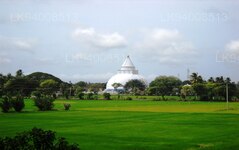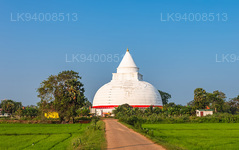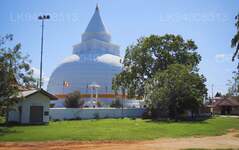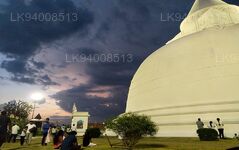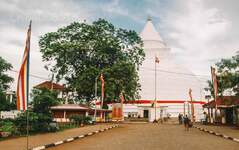
Tissamaharama City
Nestled in the heart of Tissamaharama, our hotel offers a tranquil retreat surrounded by nature. With comfortable accommodations, modern facilities, and a central location, guests can enjoy a peaceful stay. Explore nearby attractions like Yala National Park, historic temples, and scenic lakes, creating lasting memories during your visit.
Tissamaharama Raja Maha Viharaya
Tissamaharama Raja Maha Vihara, typically says the ‘Temple of Tissa,’ the 55.8m high dagoba is presumed to hold a sacred tooth relic and forehead bone relic. Adjoining wewa (lake) is said to be constructed around 200 BC by King Kavantissa resembling a common concept of ‘lake and temple’ in the good old days. Next to the dagoba is a statue of the heroic Queen Viharamahadevi; Sandagiri Stupa, presumed to be the oldest stupa in southern Sri Lanka and the area of ‘Kshatriya’ warrior clan. The stupa enshrines relics received as gifts from Emperor Asoka. A 2-3rd century BC ‘Siri Pathul Gal’ (footprint of Buddha carved in rock slabs) is among the ruins; Kirinda Raja Maha Vihara, about 10km south of Tissa is where princess Viharamahadevi drifted ashore as per legend. She was sacrificed to sea by her father King Kelanitissa of Kelaniya (close to Colombo) as a penance after he killed a monk. Subsequently, she married King Kavantissa, ruler of the Ruhunu kingdom. Their sons were Dutugemunu and Tissa, the former is the all-time admired Sinhalese king, who liberated Anuradhapura from Indian invaders, namely King Elara in the 2nd century BC and united the country.
In the city of Tissamamarama, there are 4 ancient stupas belonging to the Anuradhapura Era ara lying in a row. These are
- 1. Sandagiri Stupa
- 2. Tissamaharama Stupa
- 3. Yatala Vehera
- 4. Menik Vehera
Out of these, the most worshiped and the largest is the Tissamaharama Stupa & according to ancient chronicles this stupa has been built by King Kavantissa who ruled Ruhuna in the 1st century BC. But there is also a belief that this stupa was initially built by regional King Mahanaga in the 3rd century BC and King Kavantissa probably enlarged the shrine.
Mahanaga is a brother of King Devanampiyathissa (150-210 BC ). History states that that when Mahanaga was inspecting the construction of Walas Reservoir (වලස් වැව), the queen of Devanampiyathissa send him a bowl of Mangos with the top most one poisoned. Her intention was to kill Mahanaga to ensure the throne to her son after Devanampiyathissa. At that time the son was with his uncle at the tank and child ate the poisoned mango and died on the spot. Fearing reprisal he took his pregnant wife and escaped to Ruhuna where he built up his own regional kingdom surrounding Magama area.
About Hambantota District
Hambantota is a rural town in southeastern coastal area of Sri Lanka. It is also the capital of the Hambantota District in the Southern Province of Sri Lanka. Approximately 240 kms from Colombo, Hambantota is in the midst of transformation into a strategic port and commercial centre, undergoing extensive infrastructure development. Flanked by sweeping sandy beaches, Hambantota is a convenient location from which to visit nearby sights.
The Bundala National Park lays 20 km east of Hambantota and the Wirawila Sanctuary a little further off. The Ruhuna National Park and the Kataragama Temple are other attractions that can be accessed easily from this city.
About Southern Province
The Southern Province of Sri Lanka is a small geographic area consisting of the districts of Galle, Matara and Hambantota. Subsistence farming and fishing is the main source of income for the vast majority of the people of this region.
Important landmarks of the Southern Province include the wildlife sanctuaries of the Yala and Udawalawe National Parks, the holy city of Kataragama, and the ancient cities of Tissamaharama, Kirinda and Galle. (Although Galle is an ancient city, almost nothing survives from before the Portuguese invasion.) During the Portuguese period there were two famous Sinhalese poets called Andare who was from Dickwella and Gajaman Nona who was from Denipitiya in Matara District, composing poems on common man.

